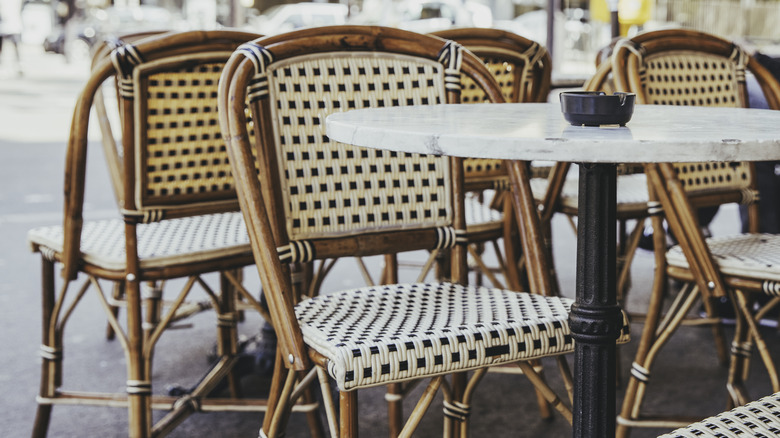What Exactly Is A Bistro Restaurant And Where Did It Originate?
The word bistro has a nice ring to it — it sounds quaint and inviting and like the kind of place where you would want to spend an afternoon having a nice meal. But what exactly is a bistro, anyway?
Merriam-Webster defines "bistro" as "a small or unpretentious restaurant." The "unpretentious" part of the definition is key, seeing as one of the most important elements of a bistro is the fact that it's a casual dining experience – you may think of it as the middle ground between a sit-down restaurant and a coffee shop. Similar to a coffee shop, bistros are often small spaces, which lend to their cozy, neighborhood vibe and atmosphere that make them feel quite welcoming. They are also strongly linked to French cuisine — and that association makes a lot of sense when we look into the history of the bistro (spoiler alert, it has a French origin).
Bistros date back to the 1800s
While the bistro has a French origins, the name may actually have a Russian origin — specifically dating back to the Napoleonic wars when the Russians invaded France. As the popular story goes, the Russian soldiers would shout "bistra" — Russian for "quick" — at the wait staff at restaurants to demand that they get faster service. The term then stuck around in France and "bistro" or "bistrot" soon began being used to refer to a casual restaurant with fast service.
The earliest bistros served as a space for the French working class to come together for a cheap and easy meal. Additionally, people were drawn to bistros because of the warmth since many working-class people didn't have heat in their apartments. Later, a bistro also became a prime spot to use a telephone (before home telephones were widespread). Considering that the earliest bistros existed in France, it will come as no surprise that their menus contained French food.
Bistros have since evolved beyond France — but maintained their core qualities
Bistros eventually evolved out of France and they had become popular in America around the 1980s, although there is little information on how the bistro made its way across the pond or which bistros paved the way for the American-set bistro. According to food critic Stephanie Lyness of the New York Times, "French bistros weave the elegance of traditional French cuisine with the everyday aesthetic of a neighborhood restaurant."
Lyness's definition proves to ring generally true for bistros in America. Certainly, bistros are still associated with French cuisine — if you Google bistros in your area, you will receive a list of French restaurants (or with French influence). Just like the earliest bistros of France, you'll find that many American bistros still have a casual atmosphere — this makes sense given that large parties going out to dinner to celebrate an occasion may want something more fanciful than a bistro.
However, Pierre Josse, the founder of the Guide du Routard travel books with deep knowledge of bistros, fears that bistros may no long be used in the same way that they were in the past. Josse told The Irish Times, "We have to tear people away from their screens, make them come back to the zinc counters," Josse says. "We have to resist Starbuckisation, the disappearance of places of socializing."


